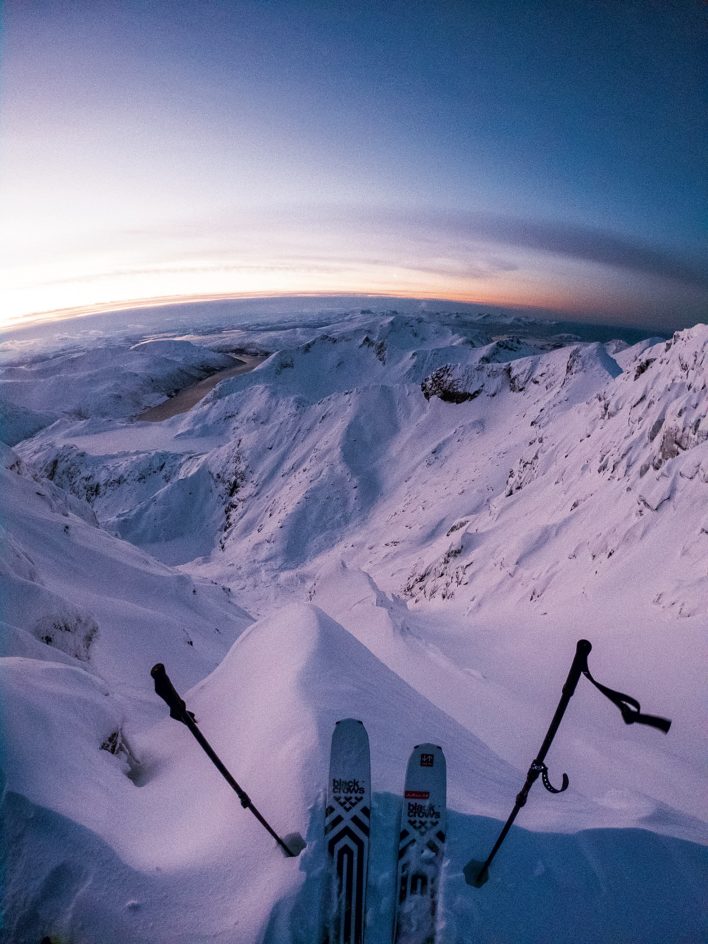On November 23, 2020, skier and filmmaker Nikolai Schirmer took a day off from filming to visit some familiar terrain near his home in Tromsø, Norway, which also happened to be the first area he’d ever toured in as a teenager. While the main zone consists of mellow slopes, Schirmer and his friend, Eivind, decided to check out one of the chutes on a steeper west face. With only a little fresh snow atop a solid base and no recent avalanche events in the area, Schirmer expected they would be dealing only with sluff management. But he was surprised when that sluff turned into a significant avalanche, all of which was documented in a video on Schirmer’s YouTube channel. Below, Schirmer retells the story in his own words. —Betsy Manero

We checked out the snow on top of the face that we’re dropping into, and there wasn’t anything funky going on with it. These two skiers had dropped before we got there. It was a bit overcast and foggy that day, so we just saw their tracks going down, and they had dug a pit on the face. So this was what was going through our heads on top of the line. When I dropped in, I didn’t think for a second that I could trigger an avalanche. I skied down the chute, and it was super good snow.
Then I hit a rock after the chute. My ski falls off, and I just stop in the middle of the face. You can hear on the GoPro clip that I’m laughing a little bit.
And then all this snow hits me in the back, and my first thought is, “Oh, that’s my sluff hitting me.” I kind of saw that coming, and then there’s more and more snow, and it’s really violent. I’d never been in an actual avalanche before, like tumbling down the mountain.
I’m trying to swim in the masses, and when the snow hits me, it keeps pushing me headfirst. I’m trying to keep swimming in the snow to get my head up and my feet down, so if I hit something, it won’t be headfirst. But I do hit this and that, and at one point I’m going over a cliff, midair, and then I keep tumbling down. There’s quite a bit of snow, but it’s not bottomless. Every time I hit the bottom I try to self-arrest. I don’t know how many times I do that. But before the spot where it flattens out and all the snow rests, I’m able to self-arrest. The snow all disappears beneath me. I think I was a dragged 200 or 300 meters.
I’m OK, but a bit shaken up. I hurt my thigh a little bit and my hip. But other than that, I was fine. The ski I lost on a rock had flown off to the side, and I look up and that’s still there. The other ski that was on my foot is gone. The binding released, and I don’t know where that ski is.
Eivind comes down after me and picks up the ski. He says that there wasn’t really a big crown anywhere. There were a few small crowns on the side of the chute, up top. We talked about it, like what could this be? The snow a little farther down on the face got a little warmer and moister, and so we didn’t get a full-on wet slide but a point release, basically. It was fanned out from the start, where it was fairly narrow, but at the bottom, it was somewhere between 50 and 100 meters wide.
What I want people to really consider is the fact that no matter how good you get at snow safety, and no matter how many courses you take or how much knowledge you attain, if you’re going into avalanche terrain, there is no way to fully eliminate the risk of avalanches. I’m not going to say that I did everything right that day. I for sure didn’t. I feel like there’s so much focus on everything that you’ve got to do right, and that’s super important, of course. You need to get all the skills and get all the knowledge. But I don’t think we talk enough about the fact that even in having all the skills and the knowledge there is still risk and there’s no way around that.
You have to really think about whether you’re willing to accept that. Accept the consequences of getting a broken leg in an avalanche or dying. It’s real out there.
This article was originally published in Issue #139. To read more, pick up your copy at BackcountryMagazine.com/139 or subscribe.











Great article, you did a fantastic job explaining the transition from sluffs to slides in a way that everyone can understand. Keep up the good work!
What a fun and informative read! Loved getting a glimpse into the world of mountain skiing and the challenges faced by pros and amateurs alike.